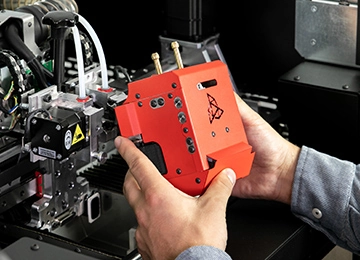Manual
Firmware
Software
Useful terms
FAQ
Guarantee terms and conditions
3DGENCE SLICER
-
Warping
This is a negative phenomenon that occurs in FFF prints affecting mainly the materials with a high thermal shrinkage. It consists in tearing the most external print elements, most commonly the corners, from the printing bed. It is prevented by using a heated table and working chamber of the device.
-
Support
This is a support added by a model designer or a slicing software (3DGence Slicer) in order to form a supporting frame for the parts of the model suspended in the air. A correctly made support is not a part of a model and can be easily removed once the printing is completed. 3DGence Slicer automatically generates supports. The support generated by 3DGence Slicer consists of two parts – a loose laid material and the so-called dense support layers, directly supporting the model itself.
-
STL
Surface Tessellation Language – one of the basic formats of 3D files. It describes only the layout of triangle apexes that make up the solid and the orientation of normal for those triangles. It does not include any information on color, materials, textures or other graphical elements being part of other more extensive 3D file formats. Originally implemented by 3D Systems company for the use of stereographic printing.
-
Slicing
The process aimed at generating paths and instructions for the printer (machine code, G-code) from a 3D model. At the level of slicer we can choose such settings as layer thickness, print speed, filling density, thickness of solid walls or nozzle and printing bed temperature. In addition, it is also possible to select the use and the density of supports and one of the few ways of improving the print adhesion to the bed (e.g. raft or brim). The 3DGence printers use the 3DGence Slicer program with predefined settings from various materials and resolutions. The final effect of slicer operation results in obtaining a machine code representing a specific 3D model in the form of G-code (g-code, *.GCODE) that is subject to interpretation by the printer electronics.
-
Skirt
Additional material printed around the model at a distance of a few millimeters from it at the very beginning of the print. The Skirt does not make an integral part of a model. Its function is to initialize and stabilize the flow of plastics through the hotend. By observing the way the printer lays skirt on the table we can assess if the table is correctly leveled and if the print adheres to it.
-
Raft
One of the methods of enhancing print adhesion to the working table. The raft is the base (bed) with a thickness of a few alternately applied layers that is generated by the slicer under the model. The raft is larger than model outline, which increases print adhesion to the table and prevents from thermal shrinkage effects (plastic to plastic connection). Another advantage of the raft is its capacity to smooth minor uneven areas of the working table. The raft makes it also easier to print models without a flat surface that could make a base. Brim and the raft should not be used simultaneously.
-
PVA
Polyvinyl alcohol – a water soluble vinyl alcohol polymer. It is used to produce water-soluble filaments, perfectly suitable for printing support structures in dual-material printing. The model itself is printed with an insoluble plastic (the most commonly with PLA), which allows for its accurate cleaning in water bath. Using an ultrasound washer results in significant acceleration of the process.
-
PLA
Polylactide – a lactic acid polymer – produced in industrial quantities with use of eco-friendly methods. The main sources for initial materials include grains, e.g. cornflour or bacterial cultures. This is a basic material for FFF technology 3D printing. Low costs, no thermal shrinkage, good adhesion to the bed and multiple filler and color variants make the PLA the most versatile and most commonly used filament. During printing it gives off a weak, neutral odor, does not emit harmful substances and is fully biodegradable. It is more fragile and susceptible to mechanical damage than ABS, that’s why its use to manufacture the prototypes of mechanical devices is limited.
-
Overhang
This is a shape of the part of a model with special significance from the point of FFF printing. An overhang can be found where a model plane forms an overhang over the working table or other model part. The 3DGence Slicer software identifies those areas and analyzes the overhang angle in relation to the working table. If the angle exceeds the value of limit angle predefined in the software, the 3DGence Slicer program automatically generates support structures for such a surface.
-
OBJ
This is a popular format of 3D files. It may contain an additional MTL (Material Template Library) file irrelevant for FFF print, containing information on material libraries defined for the model. OBJ files apart from the geometry description, apex layout and normal orientations includes information on UV coordinates for textures. It is read by the 3DGence Slicer program.
brak
brak

